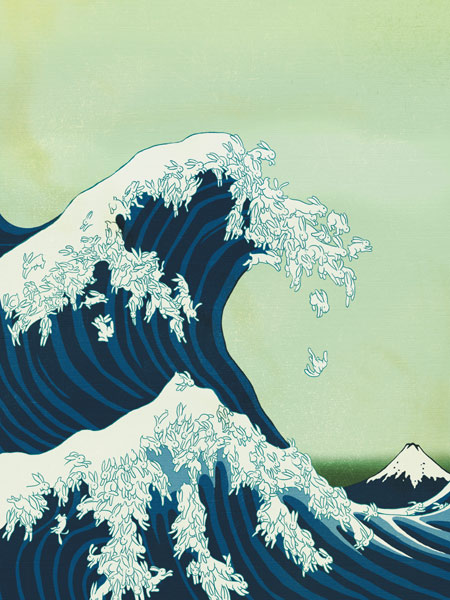 Uprisings
UprisingsThis charming cover of Giant Robot Magazine #28 by kozyndan
is for sure the furriest twist on "Behind the Great Wave at Kanagawa" by Katsushika Hokusai
via bunnylicious (where else)
 Uprisings
Uprisings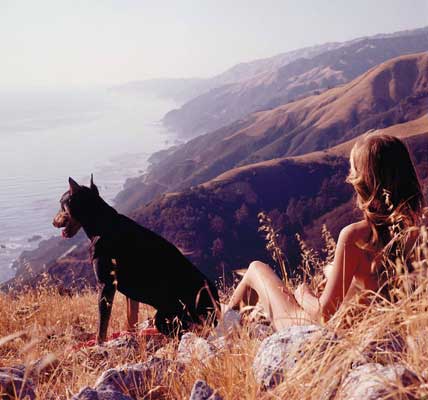
GONZO, the debut exhibition of photography by famed American author Hunter S. Thompson coincides with the release of Thompson's final book, of the same name, and chronicles his life through his own photographs and memorabilia.
GONZO began as a personal collaboration with Thompson prior to his untimely death, and has since come to completion with the support of his family and estate. The show will feature many never before seen photographs from Thompson's personal archive, including shots from his early days as a foreign correspondent in Puerto Rico, living in Big Sur in the 1960s, time on the road with the Hell's Angels, illuminating self-portraits, and many personal moments with friends and family throughout the years.
Immortalized on film by good friends Johnny Depp (Fear and Loathing in Las Vegas, 1998) and Bill Murray (Where the Buffalo Roam, 1980), Hunter became a cult hero to counter-culture youth, intellectuals and celebrities alike. Notoriously fond of firearms and hallucinogens, Thompson lived in his self-described "heavily fortified compound" in Woody Creek, Colorado. One of his most famous quotes summed up his anarchist and acerbic philosophy on life,
"I hate to advocate drugs, alcohol, violence or insanity to anyone, but they've always worked for me."
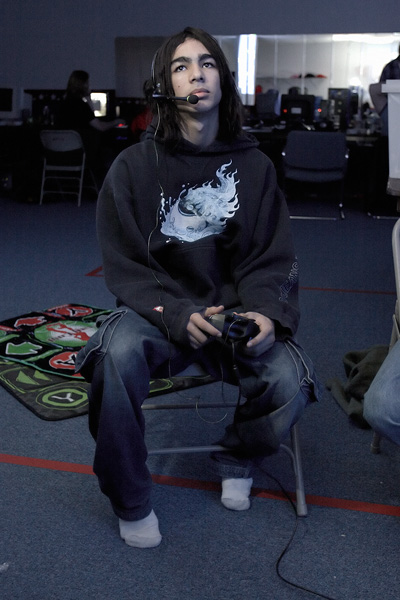
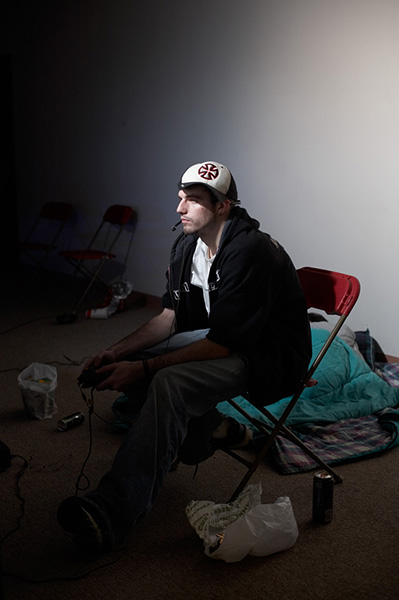
The games they play are typically first-person shooters and are extremely immersive. Much of the time is spent totally engaged in the game world, but it is a surprisingly social game world. Groups of players, called 'clans', interact in the game and communicate with each other using headsets. Every now and then when I am shooting I will hear someone say into the screen: "yeah, he's working on a documentary", or something like that. They are talking through the game with someone who is seated on the other side of the room. It is like neighborhood watch in there. It is very strange. The presence of another layer of connection becomes very clear. Much of the social interaction is immediately visible to anyone entering the building. It is no different than any other event. There is another social environment, though, that is only visible to those in the game. It is the tension between those two spaces, game space and real space, that I find very intriguing.
 Unmarked 737 at "Gold Coast" Terminal/Las Vegas, NV/Distance ~1 mile/10:44 pm, 30 x 36 inches, C-Print, Edition of 5
Unmarked 737 at "Gold Coast" Terminal/Las Vegas, NV/Distance ~1 mile/10:44 pm, 30 x 36 inches, C-Print, Edition of 5 Chemical and Biological Weapons Proving Ground/Dugway, UT/Distance ~22 miles/11:17 am, 40 x 40 inches, C-Print, Edition of 5
Chemical and Biological Weapons Proving Ground/Dugway, UT/Distance ~22 miles/11:17 am, 40 x 40 inches, C-Print, Edition of 5 Tail Numbers/Gold Coast Terminal, Las Vegas, NV/Distance ~1 mile/5:27 pm, 30 x 36 inches,C-Print, Edition of 5
Tail Numbers/Gold Coast Terminal, Las Vegas, NV/Distance ~1 mile/5:27 pm, 30 x 36 inches,C-Print, Edition of 5Black World, an exhibition by Trevor Paglen at Bellwether gallery, features a startling collection of photographs, videos, and images exploring the deepest recesses of the military industrial complex.
Over the last five years, Trevor Paglen has developing unique visual strategies to explore the "black world" of classified military and intelligence activities. To produce his photographs of secret military installations Paglen uses powerful telescopes and employs astronomical techniques to capture his subject from dozens of miles away - a proprietary technique he terms "Limit-Telephotography." The sheer distances, heat, and atmospheric distortions captured in his work result in photographs that often take on the qualities of impressionistic paintings.
Paglen is the first and only person to have photographed several of the CIA's "black sites" overseas - a collection of secret prisons whose existence (but not locations) the CIA has only recently acknowledged. These never-before-seen photographs will also be on display. Other works on view include a diverse collection of patches and symbols worn by people working on secret military programs - programs that do not officially "exist" - and forged signatures from the corporate documents of CIA front companies.
By confronting us with images of a world that cannot be seen with the naked eye, and that do not "officially" exist, Paglen asks the viewer to meditate on the limits of vision, abstraction and the nature of evidence as he performs a series of stunning interventions into the history of landscape photography.
pressrelease
I would question the claim that Trevor Paglen tells really something about the black world, for sure he tells something about how a certain kind of photography (and work titles) can still gain this aura of truth.
BLACK WORLD
Trevor Paglen at Bellwether till December 23 2006

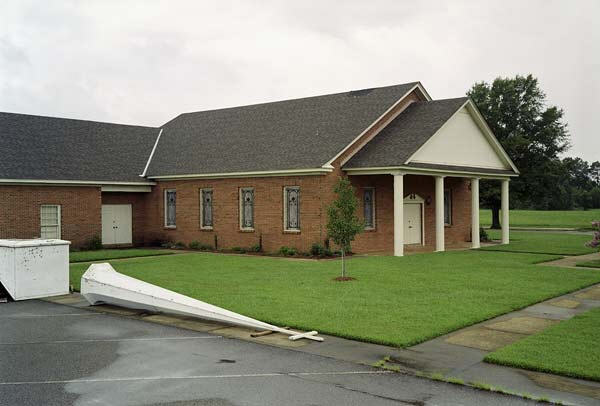
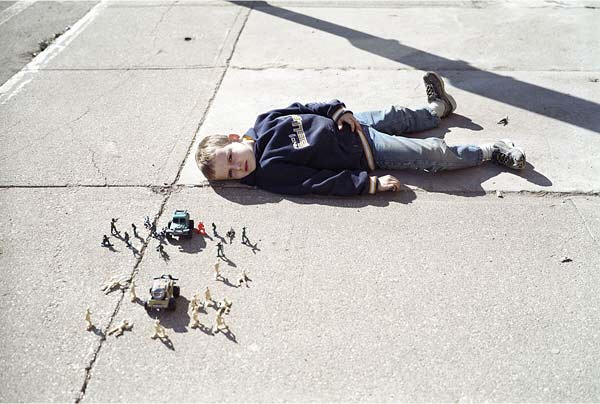
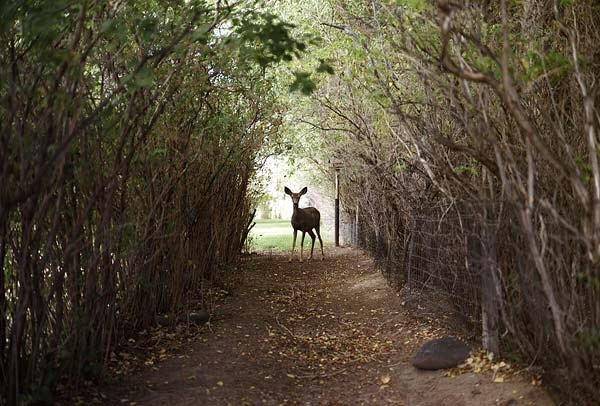

Between 2003 and 2005, I spent three and half months driving around America, searching for subjects that inspire me with wonder. This project is about the experience of first sight, the moment of visual discovery when we encounter something extraordinary. Essential to this encounter is the gap between what we see in a photograph and what we know about it. The result is a definitive unknowable: a subject that is unambiguous and understandable but the details and context of which remain a mystery to the viewer, and in some cases even to me. I hope that these photographs communicate the possibility of making photographs that both represent actual events but also contain their own fictional histories.
William Lamson
more here (don´t miss "Me In America")
another fine finding by Joerg "Conscientious" Colberg
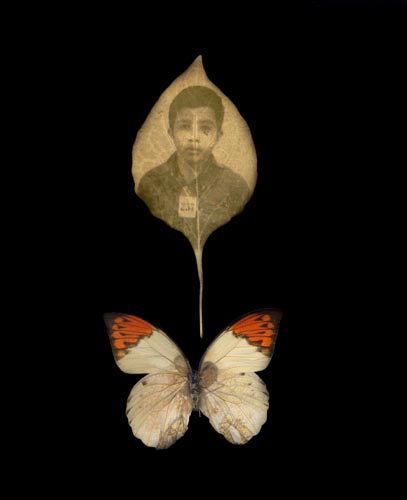 Study for Metamorphosis #2, 2006, 11.5 x 9.5 x 2 inches
Study for Metamorphosis #2, 2006, 11.5 x 9.5 x 2 inches 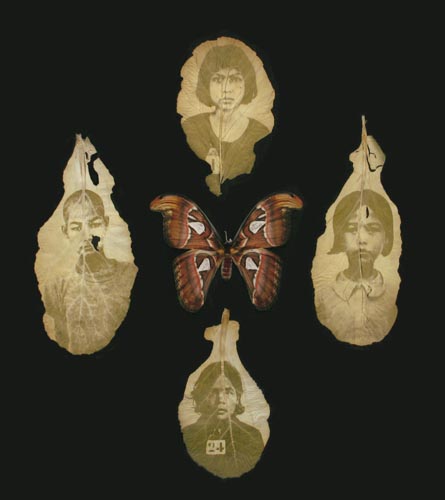 Ancestral Altar #20, 2006, 32 x 27.5 inches
Ancestral Altar #20, 2006, 32 x 27.5 inches 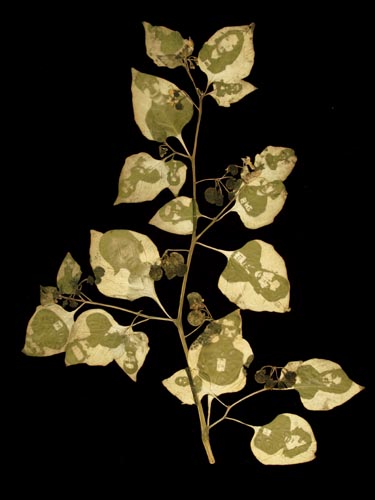 Study for Transmission #3, 2006, 17 x 14.5 x 1.375 inches Chlorophyll print and resin
Study for Transmission #3, 2006, 17 x 14.5 x 1.375 inches Chlorophyll print and resinBinh Danh was born in Vietnam in 1977 before his family immigrated to the United States that same year.
Danh has invented a technique for printing found photographs (digitally rendered into negatives) onto the surface of leaves by exploiting the natural process of photosynthesis. The leaves, still living, are pressed between glass plates with the negative and exposed to sunlight from a week to several months. Coined "chlorophyll prints" by the artist, the fragile works are encapsulated and made permanent through casting them in solid blocks of resin. By conjoining his process into his conceptual ideas so completely, Danh is also able to reference the history and technical developments of photography.
He says of his work, "Throughout my education, I have always been very attracted to Art, History, and Science. The histories I search for are the hidden stories embedded in the landscape around me. The processes used in my work represent my interest in the sciences and photographic techniques."
Binh Danh at Haines gallery
via
Since a while I am in my midlife crisis, thinking a lot about the purpose of my life, what will remain and things like that. Since I don't have a specific talent to make my mark nor even managed to arrange some kids to reflect my existence or even have a beloved one that will never forget me I guess I am just one of many who just will be forgotten..That sucks, but instead of endulging my self into depression I desperatly started looking for a solution and I came up with this idea... The Bert Simons Paper-Clone

I am quiete pleased with the result. It's nice to have myself around..yesterday evening I noticed I even talk to them. It is a good therapy too, they help a lot to accept myself and I even got used to my bold spot.
next thing will be a full body clone, the first experiment I just started..unfortunatly I mixed up some chromosones and turned out a girl
Finally my presence isn't restricted to my personal whereabouts anymore. Have me around wherever you are!
right click on this link and save the pdf file to your computer. Print the 12 pages with over 100 parts on thick (80 grams) paper and start cutting and glueing and make your own personal Bert.
I'll show a gallery of clones build by people all over the world as soon as the first ones have been finsihed.
 Reclining Nude (Sleep), 1933
Reclining Nude (Sleep), 1933"Daughter of an Indian father and an European mother, irrepressibly sensual yet often oddly detached, her artistic life divided between Paris and Punjab, the contradictory forces in Amrita Sher-Gil's nature and background came triumphantly together in her art,
if not in her life. A founder of Indian modernism, it is time that her genius is recognized beyond the country's borders."
Sudhir Kakar
 Brides Toilet, 1937
Brides Toilet, 1937
Amrita Shergil, daughter of Sardar Umrao Singh Shergil and Antoinette, a Hungarian lady endowed with considerable artistic talent, was born in Budapest in 1913, and spent the formative years of her life in Europe. She dabbled in paint from her early childhood. Her intelligent mother detected the talent latent in her, and encouraged her to paint. In 1929 when she was sixteen years old, her mother felt it was time for Amrita to start an academic training in art: so the family set out for the capital of European culture, Paris.
In a matter of months Amrita had learnt to speak french fluently and with great ease adapted herself to the Parisian way of life. Her domineering mother took the girls to see 'good' theatre and concerts, and would arrange soirees of so called intellectuals, musicians and writers, at which she would present her daughters. Amrita detested these salon gatherings and stopped going to conventional plays and operas when she discovered the off-beat and avant garde theatres frequented by her artist friends.
The dark corners and smoky cafes of Bohemian Paris opened up their secrets to a new and thrilled Amrita who entered them with wild abandon. Here she met creative and unconventional people, whom she identified with characters from the books she had absorbed during her period of moody introspection. Amrita now became the uninhibited vivacious and happy person, which she appears to be in some of her early self-portraits. This was a different Amrita, an extrovert whose life became an eternal round of parties, concerts, theatres, films and exhibitions. Wherever she went people noticed her Eurasian looks, were captivated by her exotic charm and struck by her intelligence and confidence.She was famous for her many affairs with both women and men.
Though she wanted to imbibe the air of the leafy boulevards of the French capital and sample its inimitable cafe life, this young woman would return to India in a few years' time and go on to become India's first and most famous female artist of the century. Emancipated, yet responsible, fun-loving but serious, assertive yet fragile, she provided a role model for women artists of future generations.
Amrita's work done during her stay in Europe till 1934 was largely academic, consisting of still-life, nude studies, portraits and the like. Her genius was to flower only after her return to her fatherland, India. She came here not as a foreigner attracted by the 'picturesque' India, and the exotic sights and smells; she came here as an Indian in feeling and spirit and with a mind to make this land her home. Despite her training in western art, she had complete awareness of and deep respect for India's artistic traditions. When she set foot on Indian soil for the first time in November 1934, she was haunted by the faces of the unhappy and dejected, poor and starving Indians whom she saw first around Simla, then in the South and finally in Punjab, where she was to spend the last days of her life (She died in Lahore in 1942).
more here
Amrita Sher-Gil
Eine indische Kuenstlerfamilie im 20. Jahrhundert
(An artist family from India in the twentieth century)
at Haus der Kunst Munich till january 2007
via


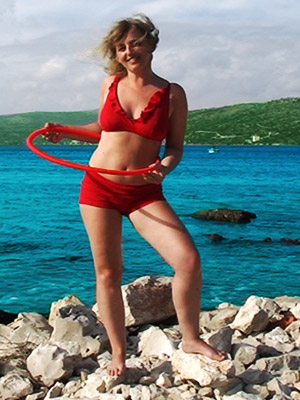


12 portraits based "beach pin up photography". Each pose was shot on video for 4 minutes and each person was asked hold that same pose for the entire duration.
For this work I was interested in...
-the captured "moment" in photography
- the plethora of digital snapshots versus the slow careful posing of earlier photography
-the presentation of one's self for the camera
-the steady gaze of the person being filmed
-the dynamics between the subject and viewer. In earlier portraiture the presence of the viewer was often strongly felt, as opposed to the voyeuristic tendencies of the contemporary viewer.
-the careful composition and slow nature of old photo techniques
-the artificiality of posed photographs
-the pockets of time held within an image, like a time capsule is enhanced through the video of a singular yet very alive image
-the awkwardness of keeping up appearances, of maintaining a pleasant expression for an extended period of time, how an expression of joy becomes cruel and uncomfortable as time goes by
Kim Collmer



Most time I photograph people in their own environments because it is personal, familiar, and comfortable for them. For me as a photographer, the situation becomes rather peculiar, intimate, and doubtful. Once I achieve the trust of the model, I can feel their energy and their desire to be seen and be explored but at the same time still reserve some for themselves. It is in those Almost Naked moments that my subjects are the most exquisite, when things occur, and what generally is not displayed initially in public is exposed.
Shen Wei in conversation with Joerg Colberg
 bears, c-print, 60x70 cm (23.6x27.5 inches), ed. 1/8, 2002
bears, c-print, 60x70 cm (23.6x27.5 inches), ed. 1/8, 2002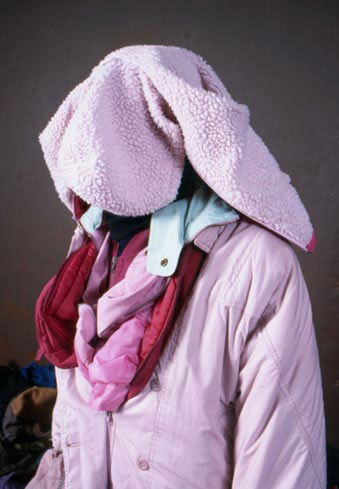 the rabbit inside the cave, c-print, 60x70 cm (23.6x27.5 inches), ed. 1/8, 2002
the rabbit inside the cave, c-print, 60x70 cm (23.6x27.5 inches), ed. 1/8, 2002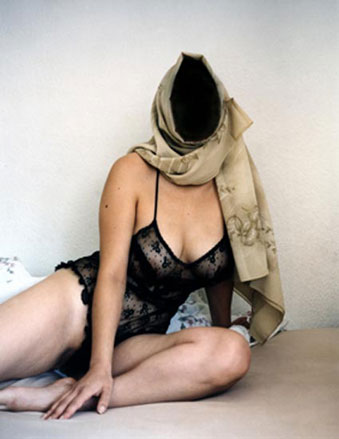 waiting for something beautiful to happen, c-print, 60x70 cm (23.6x27.5 inches), ed. 1/8, 2002.
waiting for something beautiful to happen, c-print, 60x70 cm (23.6x27.5 inches), ed. 1/8, 2002.My ideas are jingles in my head, they come to me. To be able to make a song i have to give stucture to the melodies, like i have to put the thoughts and idea's into matter to be able to impart the information and touch someone like it touched me first.
My work is an irregular impulse of experiences and aesthetic enjoyments stemming from the questions I have and the things that I know. I am not interested in a particular truth or a common reality, but I do have to understand and embody my truth, which I find from looking within. Although these things might be universal, consequently, questioning myself leads to the act of questioning you. Nothing should control the spirit....
Holding your gaze upon my photographs is an invitation to play. Confrontation can be liberating but it can also be bizarre. Melancholy and humor are important aspects for me. It might hurt a little, too.
Melanie Bonajo

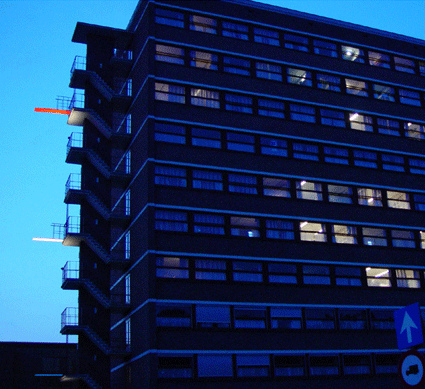

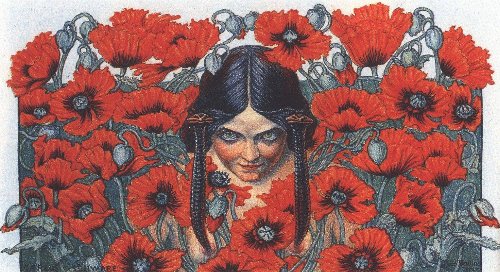
 click pic for highrez
click pic for highrezLes Fleurs du mal • Die Blumen des Boesen, Charles Baudelaire Edition Charles Meunier
Illustrated by Carlos Schwabe, 1866 - 1926
first published: 1900

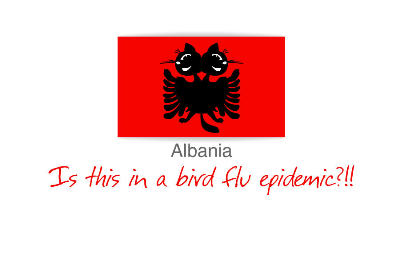
 Auch das Zufaelligste ist nur das auf entfernterem Wege herangekommene Notwendige Schopenhauer
Auch das Zufaelligste ist nur das auf entfernterem Wege herangekommene Notwendige Schopenhauer Olaf Martens, Nicole, Grosskugel, 1994 © Olaf Martens, Courtesy Galerie f5,6.
Olaf Martens, Nicole, Grosskugel, 1994 © Olaf Martens, Courtesy Galerie f5,6.PARIS, FRANCE.- Paris Photo celebrates its tenth anniversary with a sparkling selection of Nordic talent Guests of honour: Denmark, Finland, Iceland, Norway & Sweden. From November 16-19, 2006, Paris Photo celebrates its first decade with an outstanding panorama of 19th century, modern and contemporary photography, bringing together 108 exhibitors (90 galleries and 18 publishers) at the Carrousel du Louvre.
more here
via